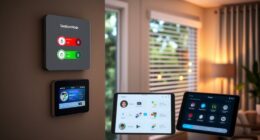Yes, wireless home security systems can be vulnerable to hacking, potentially putting your home at risk. These systems often rely on Wi-Fi, making them susceptible to various types of hacks such as brute-force attacks and phishing. The risks are further increased by weak passwords and outdated firmware. Warning signs of a potential breach may include unexpected camera movements or difficulty logging in. To strengthen security measures, it is recommended to use strong, unique passwords, implement two-factor authentication, and consistently update all your devices. By following these suggested strategies, you can enhance your home security and protect against potential intrusions. There are still numerous ways to bolster your security, so continue to explore different options to stay well-informed.
Key Takeaways
- Wireless home security systems are vulnerable to hacking due to reliance on Wi-Fi networks and potential interception of signals.
- Weak passwords and poor authentication methods make systems easy targets for brute-force attacks.
- Jamming devices can disrupt communication between security sensors, rendering systems ineffective.
- Signs of hacking include unexpected camera activity, inability to log in, and alerts from monitoring services.
Understanding System Vulnerabilities
Understanding system vulnerabilities in wireless home security systems is essential, as even small weaknesses can expose your home to serious risks. Many of these systems rely on Wi-Fi networks for communication, making them vulnerable to interception by attackers.
AI security provides robust defenses against such cyber threats, utilizing advanced algorithms for real-time threat detection and increasing efficiency in monitoring and analyzing security incidents.
Weaknesses in authentication methods, like short passwords, leave your security system open to brute-force attacks. Nearly 50% of Americans use passwords of 8 characters or less, which makes gaining unauthorized access easier for hackers.
Signal disruption poses another significant threat; inexpensive devices can jam signals, preventing your monitoring service from receiving alerts. For instance, during a notable incident in 2019, a device costing just $2 was used to exploit such vulnerabilities effectively.
Additionally, systems like Ring have faced issues due to back-end vulnerabilities and a lack of user awareness regarding login activities.
Common Hacking Techniques

Wireless home security systems face various hacking techniques that can compromise your safety and privacy. Understanding these methods helps you take preventive measures against unauthorized access. For instance, the rise of cybersecurity challenges highlights the importance of being aware of potential threats.
- Phishing: Hackers send fake emails or texts to steal your credentials.
- Brute-force attacks: These involve guessing weak passwords until access is gained.
Additionally, credential stuffing exploits reused usernames and passwords from previous data breaches, making it easier for hackers to gain unauthorized access.
Jamming attacks disrupt communication between your security sensors and monitoring centers, often requiring specialized equipment.
Local attacks may involve physically accessing control rooms to manipulate CCTV feeds.
It's essential to strengthen your defenses against these common hacking techniques. Use strong, unique passwords and stay vigilant against phishing attempts. By understanding these tactics, you can better secure your wireless home security system and protect your home from potential threats.
Signs of a Hacked System

Several signs can indicate that your home security system has been hacked, and recognizing them quickly is vital for your safety.
One major red flag is unexpected activation of your camera's LED lights, suggesting remote access. If you notice erratic camera movements—like sudden panning or tilting—it could mean a hacker has taken control. Additionally, unrecognizable noises from your cameras, such as static or strange sounds, may point to unauthorized access.
It's important to reflect on how understanding security in payment processing can also apply to securing your home technology.
You should also be cautious if you can't log into your system despite not changing your password; this might indicate a hacking attempt. Keep an eye out for logins from unknown devices or locations, as these are clear signs of a hacked system.
If you're utilizing professional monitoring, they might alert you to unusual activity, but you should still remain vigilant.
To protect your system, being aware of these signs is essential. By identifying these potential issues early, you can take steps to secure your home and prevent further intrusion.
Protection Strategies

To keep your home security system safe from hackers, start by implementing strong, unique passwords and enabling two-factor authentication. These strategies greatly lower your vulnerability to hacking attempts. Additionally, consider the importance of AI advancements in enhancing cybersecurity measures. Change any default passwords immediately, as they're often easy targets.
Consider the following protection strategies:
- Utilize encryption standards like Wi-Fi Protected Access (WPA2 or WPA3) to safeguard data transmission over your network.
- Regularly perform firmware updates on your devices, keeping them secure and addressing any vulnerabilities.
Comparing Security System Options

When choosing a home security system, you'll find various options that cater to different needs and budgets.
If you prefer a DIY approach, DIY Home Security Systems typically start around $199.99 with a monthly fee of $20.00. These systems allow self-monitoring without a contract, making them attractive for budget-conscious consumers. A methodical approach to evaluating your options can help you select the right system for your home.
On the other hand, if you want professional assistance, options like Vivint and ADT offer professional installation and smart home compatibility, but they come with monthly fees around $28.99 to $29.99 and require contracts.
Cove is a good middle ground, providing both DIY and professional installations for $17.99 monthly, without a contract. SimpliSafe also emphasizes flexibility, offering both installation types starting at $245.00.
Incorporating smart home devices like video doorbells and home security cameras can enhance your setup.
Whichever option you choose, remember to follow best practices for security protocols. Utilizing password managers and enabling multi-factor authentication can further secure your wireless alarm systems against potential hacking attempts.
Future Trends in Home Security

As you look to the future of home security, you'll notice a strong focus on enhanced encryption protocols and AI-driven solutions.
These advancements are set to make your security systems smarter and more resilient against threats, while design thinking principles can guide the development of user-centered security features.
Plus, the integration with smart devices means you'll enjoy a more seamless and effective security experience.
Enhanced Encryption Protocols
Enhanced encryption protocols are redefining the landscape of wireless home security systems, making them more resilient against unauthorized access. With the rise of protocols like WPA3, you can expect stronger defenses against hacking attempts that threaten your home's safety.
These advancements aren't just theoretical; they're actively being implemented to enhance data protection. As strategies for increasing topical authority continue to evolve, manufacturers are prioritizing security measures to meet consumer demands.
Imagine:
- Your security camera's feed encrypted end-to-end, ensuring only you can view it.
- Regular firmware updates that keep your system fortified against the latest cyber threats.
Manufacturers are increasingly adopting end-to-end encryption methods, as seen with Ring's response to a major breach. This means data transmitted between your devices remains confidential and out of reach from hackers.
Continuous updates are essential to address evolving threats, and many systems now prioritize these updates to maintain high encryption standards. As consumers become more aware of vulnerabilities, the demand for robust encryption features is surging.
Investing in wireless home security systems with these enhanced encryption protocols will give you peace of mind, knowing your home is better protected against potential intrusions.
AI-Driven Security Solutions
The rise of AI-driven security solutions is transforming how homeowners protect their properties, building on the robust encryption protocols that safeguard data integrity.
With advanced machine learning algorithms, these security systems analyze patterns in user behavior, detecting anomalies that may indicate security breaches. This importance of quality assurance in software development enhances the reliability of these systems.
This automation enhances your home's protection, continuously monitoring video feeds from cameras and sending real-time alerts for unusual movements.
By distinguishing between benign activities, like pets or family members, and potential intruders, AI-driven security solutions reduce false alarms, improving your user experience.
Data privacy is a top concern, and as these systems evolve, they'll likely incorporate enhanced encryption protocols and biometric authentication methods, making them less vulnerable to hacking.
Moreover, predictive analytics powered by AI can help you anticipate potential threats based on historical data and trends.
When authentication requires multiple verification layers, your access to security is further secured, especially when connected to a wireless router.
In a world where security threats are constantly evolving, embracing AI-driven solutions is a proactive step toward ensuring your home remains safe and secure.
Integration With Smart Devices
Wireless home security systems are stepping up their game by integrating seamlessly with smart devices, giving you effortless control and monitoring through your favorite mobile apps and voice assistants. This integration enhances your ability to protect your home while guaranteeing a user-friendly experience.
With the rise of D.I.Y security systems, you can customize your security setup without the need for a security company.
Consider the benefits of these integrated smart devices:
- Real-time alerts sent to your smartphone for any unusual activity.
- Voice commands that allow you to control your security system hands-free.
As manufacturers focus on robust encryption and authentication methods, the wireless signal connecting these devices is becoming more secure.
Collaboration with cybersecurity experts is essential to prevent privacy violations and guarantee that your systems maintain a strong layer of protection.
By choosing integrated smart devices, you not only enhance your home's security but also enjoy the convenience and flexibility that modern technology offers.
Stay informed and proactive to safeguard your connected devices against potential threats.
Frequently Asked Questions
What Home Security System Cannot Be Hacked?
No home security system's completely hack-proof, but you can choose systems with strong encryption, hardwired connections, and continuous monitoring. Look for reputable brands like ADT or SimpliSafe for better protection against potential threats.
Can Burglars Jam Your Wireless Security System?
Burglars can indeed jam your wireless security system, but it's rare. Most prefer simpler methods. Some systems, like Blue by ADT, resist jamming effectively, ensuring your home's safety isn't solely dependent on technology.
How Secure Are Wireless Alarm Systems?
Wireless alarm systems offer convenience but come with security concerns. You should guarantee your system uses strong, unique passwords, regularly updates its software, and incorporates anti-jamming measures to enhance protection against potential threats.
What 5 Home Security Systems Are Vulnerable to Hackers?
When it comes to security, not all systems shine equally. Cove, Eufy, Ring, SimpliSafe, and Abode Iota show vulnerabilities, making them less than ideal choices if you're aiming for robust protection against potential intrusions.
How Can I Protect My Wireless Home Security System from Being Hacked?
Protecting your wireless home security system from potential hacks is crucial. Start by regularly updating your system’s firmware and using strong, unique passwords. Enable two-factor authentication for an added layer of security. Consider investing in a firewall and using encrypted communication protocols to safeguard against potential home security system hacks.
Conclusion
In the ever-evolving landscape of home security, staying one step ahead of potential hackers is essential.
You wouldn't leave your front door wide open, so why risk your digital safety?
By understanding vulnerabilities and employing robust protection strategies, you can safeguard your home like a fortress.
As technology advances, so do the threats, but with vigilance and the right tools, you can keep your sanctuary secure and sleep soundly at night.
Don't wait—act now to protect what matters most!









